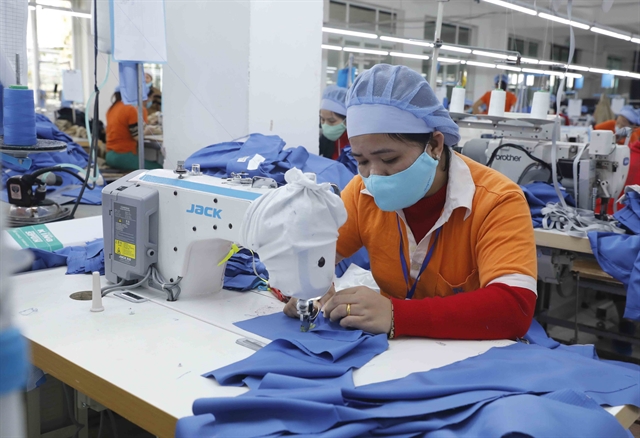The demand for textiles and garments will tend to decrease due to the overbought of consumers in 2021, while high inflation is cutting people's spending on unnecessary products.

Textile and garment export turnover in the first six months of 2022 is estimated to increase 23 per cent on-year to about US$22 billion, reaching the highest level ever, according to the Viet Nam Textile and Apparel Association.
Of which, the US market played an essential role for the industry. Data from the General Department of Customs of Viet Nam showed that textile and garment exports in the first five months of 2022 to the US market increased by 26 per cent over last year to $7.58 billion, accounting for 57 per cent of the total value of Viet Nam’s textile and garment exports.
The newly updated report by Viet Dragon Securities JSC (VDSC) said that these figures imply that the prospects of the country’s textile and garment industry will depend heavily on economic developments in the US market.
However, in the second half of 2022, VDSC forecasts that the demand for textiles and garments will tend to decrease due to high consumption in 2021, while inflation is cutting people's spending on unnecessary products.
The US market also began to show many warning signs of a cooling down in apparel demand. In the first quarter of 2022, clothing accounted for just 3.9 per cent of total US consumer spending, down from 4.3 per cent in 2019 before the pandemic. According to Vinatex, the US market's textile and garment import demand is likely to decline by 7-10 per cent in the second half of 2022.
On the other hand, the US ban on cotton originating from the Xinjiang region that officially took effect on June 21 also caused disruptions in the supply chain and contributed to higher cotton prices.
VDSC data shows that only 10.5 per cent of US cotton apparel imports came from China in April, down from about 15 per cent at the beginning of the year. The ban may affect the source of raw materials of Vietnamese enterprises and create barriers when exporting to the US market.
But this can also be an advantage for large textile and garment enterprises in Viet Nam, who have the ability to diversify sources of raw materials, replacing orders to the US of Chinese companies.
Besides, the shutdown of China's economy also contributed to the shift of orders from China to Viet Nam recently. In April, China's market share in textile imports to the US fell to a new record low of 26.3 per cent in volume and 16.8 per cent in value.
"In the second half of 2022, companies in the industry will be under stronger pressure due to high inflation affecting local consumers as well as export markets," Le Xuan, a senior trader, told Viet Nam News.
"Input costs are also expected to climb as supplies depend on the China market, while logistic expenses inch higher."
Profit margin improves on cooling material costs
The dual effects of post-COVID-19 supply chain disruptions and the Russia-Ukraine conflict has triggered gains the price of yarn and cotton imported into Viet Nam, up an average of 10 per cent year-on-year in the first five months of the year.
VDSC believes that higher costs weighed on profit margins of companies in the industry as most of them recorded decreases in gross margin in the first quarter of 2022.
Analysts said that the raw material problem will only be solved when China gradually reopens its economy, as most of the raw materials for the Vietnamese textile and garment industry are imported from China.
China is also showing some positive signs in easing border restrictions on recession worries in the second half of this year. It is expected to help gradually reduce input costs for businesses and improve profit margins for the rest of 2022.
According to VDSC, there is likely to be divergence among the profits of Vietnamese textile and garment companies in the second half of the year. Specifically, the last six months of 2022, domestic manufacturers will aggressively compete in terms of both input materials and output as orders are no longer as abundant as in the first half of the year.
“At that time, large-scale businesses with a stable customer base and products in less tight spending segments like sports-related products and high-end products, will have a more competitive advantage," VDSC added.
Regarding the prospects of enterprises in the industry in the second half of 2022, VDSC believes that some enterprises will be able to grow better than the industry in general, thanks to their expanded production capacity and large customer base. Moreover, they also less affected by the cost of raw materials than other companies in the industry, mainly due to the FOB method.
In a recent report, SSI Research also estimated that revenue growth of textile and garment manufacturing companies in Viet Nam will decelerate in the last six months of 2022 and 2023.
Yarn, fabric, logistics and labour costs are expected to remain at high levels due to rising oil prices and competition in the labour market – mainly among FDI factories.
On the stock market, these stocks are also likely to face divisions, depending on many factors, Xuan said.
"Enterprises, which manage their expenses, have stable input costs, diversify in raw materials sources and increase product values, can grow in the future," she added. — VNS
- Tags
- Textile enterprises





